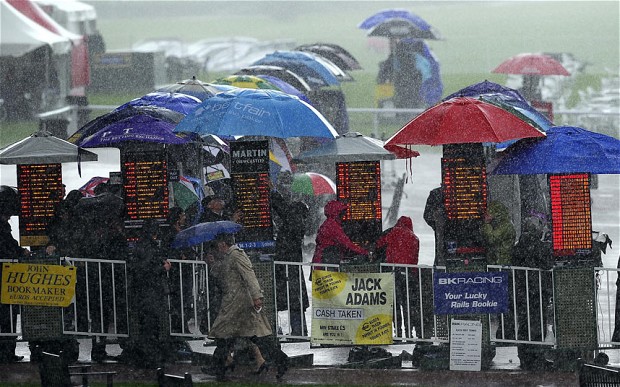
England and Wales have already received more than double the long-term average rainfall for the month
The Environment Agency said that the recent deluges had meant that the last three months have seen more rainfall than at any time since 1910 when the first readings were made.
The highest rainfall was in Wales, parts of which saw 17 inches fall during the time.
The "driest" area was the Anglian region with 11 inches.
The Environment Agencies, which monitors rainfall levels as part of its brief to avoid droughts, made the announcement as the clean-up after being battered by the latest torrential downpours battered homes and the transport network.
Last week alone more than three inches of rain fell in the North West and more than two inches in the North East, South West and Wales.
England and Wales have already received more than double the long-term average rainfall for the month.
The record rainfalls came just at the right time as many parts of the country were in drought and faced hosepipe bans.
Nearly half of the rivers the Environment Agency monitors are at exceptionally high levels, with all rivers higher than or at normal levels for the time of year.
Four water companies, Sutton and East Surrey Water, South East Water, Veolia Water Central and Veolia Water South East, which rely heavily on groundwater from chalk aquifers for customer supplies, still have hosepipe bans in place.
Levels at all but three reservoirs are classed as normal or higher for this time of year, while groundwater levels are largely improving after two dry winters in a row left much of England in drought conditions.
Polly Chancellor, national drought coordinator, said: "The wettest April to June on record has meant that river and reservoir levels across England and Wales are now normal or above for the time of year, but in some parts of the country, flooding has caused serious problems.
"Groundwater levels are now largely improving."
Meanwhile much of the north of England and Scotland was still counting the cost of the recent tropical-style storms as a massive clear up operation got under way.
Warm air form Spain clashed with a cold front coming off the Atlantic causing spectacular thunderstorms in the north east and west.
At times up to an inch of rain came down in an hour and parts of the country were damaged by hail stones biggest than golf balls.
More than 111,000 lightning strikes over the UK, with 1,000 in a five minute period across the country at the peak of activity.
MeteoGroup forecaster Paul Knightley said: "There was an incredible amount of lightning and a high number of ground strikes."
More than 40 tons of earth had to be removed from London to Scotland East Coast mainline after a landslip and the bad weather left many roads impassable, with Tyneside, Herefordshire, Worcestershire and Cumbria just some of the areas where flooding affected motorists
Northern Powergrid said around 3,000 customers were still without power following the storms - down from 23,000 last night.
The worst-hit areas included Consett, Whitley Bay, Prudhoe, Shiremoor and Stanhope.
A musical festival this weekend expected to attract more than 100,000 revellers - the Godiva Festival in Coventry's War Memorial Park - was cancelled due to the heavy rain.
Labour urged the Government to ensure flood-hit communities received funding to help with clean-up costs.
The Environment Agency said today that the April to June period this year was the wettest on record across England and Wales.
England and Wales have already received more than double the long-term average rainfall for the month of June
The figures, which do not include yesterday's torrential rain across parts of the country, show the UK had received an average of 5.1 inches up until June 27.
The figure is just a fifth of an inch off the total for 2007, which was the wettest June on record dating back more than a century.
That year swathes of England were hit by flooding in June and July.
Meanwhile, maths teacher Mike Ellis was killed after being swept away by floodwater in a stream at Bittlerley, near Ludlow, Shropshire, yesterday morning.
And a 90-year-old man was among a number of people rescued from vehicles by fire crews following flash flooding in the Bridgnorth area of the county.
Northern Ireland and the Irish republic were also hit by floods and at the height of disruption, more than 10,000 homes in the Cork area and 1,000 in Northern Ireland suffered blackouts.
The Environment Agency has 10 flood warnings in place in the Midlands, North East and North West, but the worst of the weather looks to be over.
Nick Prebble, a forecaster for MeteoGroup, the weather forecasting arm of the Press Association, said: "Today there will be a mixture of sunshine and showers across the UK with temperatures cooling off.
"Most parts of Britain could experience the odd passing shower during the day, but the focus of the heavy downpours will be across Scotland.
"Northern parts could also have a few thunder storms but the weather doesn't appear to be as severe as yesterday."
The floods are the latest to hit parts of the UK, as this month shapes up to be one of the wettest Junes on record - possibly surpassing June 2007 when heavy rain caused widespread flooding.



Reader Comments
to our Newsletter